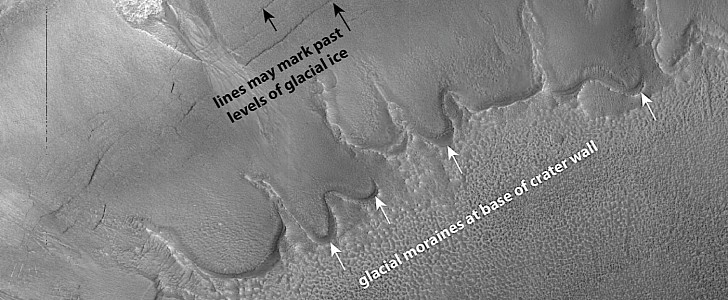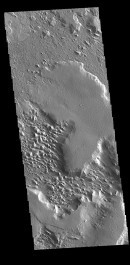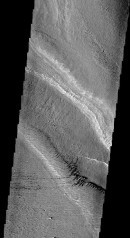Remember those World War II documentaries where they show you the movement of troops as they attack or fall back, using maps of the frontlines, with arrows to showcase the direction of motion? Well, that’s not what we have here, although that’s what it may look like.
What we’re seeing is another image from Mars, one of the tens of thousands sent back by the HiRISE camera that has been orbiting the planet for years. It was captured from an altitude of 304 km (89 miles) back in August, and it shows an undisclosed region of the planet.
Scientists at NASA and the University of Arizona, who are tasked with receiving and interpreting the HiRISE images, say we’re looking at a small part of an impact crater, whose ridge gives us a glimpse of a long-gone glacier in the area.
Titled The Writing Is on the Wall, the photo shows curved, u-shaped ridges formed by the accumulation of rocks on the surface of the glacier as it moved downslope. Now, ice is no longer to be seen in the area, but these features, called moraines, tend to remain even long after the ice is gone, and this is how we get to see them, looking like some map of the substance’s plans for an offensive.
The moraines are accompanied by linear ridges which, according to scientists, may be signs of the past levels of ice in the region. “Although glaciers move slowly, ice is a very powerful way to modify the surface of a planet,” we’re told.
Impressive visually, these continuous discoveries about the neighboring planet help us humans get a better understanding of the place we might once call our second home. With several missions to Mars planned in the near future, we expect to uncover more and more incredible things about the planet’s past and present.
Scientists at NASA and the University of Arizona, who are tasked with receiving and interpreting the HiRISE images, say we’re looking at a small part of an impact crater, whose ridge gives us a glimpse of a long-gone glacier in the area.
Titled The Writing Is on the Wall, the photo shows curved, u-shaped ridges formed by the accumulation of rocks on the surface of the glacier as it moved downslope. Now, ice is no longer to be seen in the area, but these features, called moraines, tend to remain even long after the ice is gone, and this is how we get to see them, looking like some map of the substance’s plans for an offensive.
The moraines are accompanied by linear ridges which, according to scientists, may be signs of the past levels of ice in the region. “Although glaciers move slowly, ice is a very powerful way to modify the surface of a planet,” we’re told.
Impressive visually, these continuous discoveries about the neighboring planet help us humans get a better understanding of the place we might once call our second home. With several missions to Mars planned in the near future, we expect to uncover more and more incredible things about the planet’s past and present.






